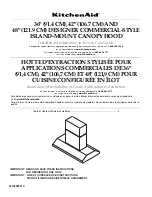
2
TO REDUCE THE RISK OF FIRE, ELECTRIC
SHOCK OR INJURY TO PERSONS, OBSERVE
THE FOLLOWING:
1.
Use this unit only in the manner intended by the
manufacturer. If you have questions, contact
the manufacturer at the address or telephone
number listed in the warranty.
2.
Before servicing or cleaning unit, switch
power off at service panel and lock service
disconnecting means to prevent power from
being switched on accidentally. When the
service disconnecting means cannot be locked,
securely fasten a prominent warning device,
such as a tag, to the service panel.
3.
Installation work and electrical wiring must be
done by qualified personnel in accordance with
all applicable codes and standards, including
fire-rated construction codes and standards.
4.
Sufficient air is needed for proper combustion
and exhausting of gases through the flue
(chimney) of fuel burning equipment to prevent
backdrafting. Follow the heating equipment
manufacturer’s guidelines and safety standards
such as those published by the National
Fire Protection Association (NFPA) and the
American Society for Heating, Refrigeration
and Air Conditioning Engineers (ASHRAE) and
the local code authorities.
5.
When cutting or drilling into wall or ceiling, do not
damage electrical wiring and other hidden utilities.
6.
Ducted fans must always be vented to the
outdoors.
7.
Do not use this unit with any additional
solid-state speed control device.
8.
To reduce the risk of fire, use only metal ductwork.
9.
This unit must be grounded.
10.
As an alternative, this product may be installed
with the UL-approved cord kit designated for the
product, following instructions packed with the
cord kit.
11.
When applicable local regulations comprise
more restrictive installation and/or certification
requirements, the aforementioned requirements
prevail on those of this document and the installer
agrees to conform to these at his own expenses.
TO REDUCE THE RISK OF A RANGE TOP
GREASE FIRE:
a)
Never leave surface units unattended at high
settings. Boilovers cause smoking and greasy
spillovers that may ignite. Heat oils slowly on
low or medium settings.
b)
Always turn hood ON when cooking at high heat
or when flambeing food (i.e.: Crêpes Suzette,
Cherries Jubilee, Peppercorn Beef Flambé).
c)
Clean ventilating fan frequently. Grease should
not be allowed to accumulate on fan, filters or in
exhaust ducts.
d)
Use proper pan size. Always use cookware
appropriate for the size of the surface element.
1.
For indoor use only.
2.
For general ventilating use only. Do not use to
exhaust hazardous or explosive materials and
vapors.
3.
To avoid motor bearing damage and noisy and/
or unbalanced fan blade, keep drywall spray,
construction dust, etc. off range hood.
4.
Your hood motor has a thermal overload
which will automatically shut off the motor if
it becomes overheated. The motor will restart
when it cools down. If the motor continues to
shut off and restart, have the hood serviced.
5.
For best capture of cooking fumes, the bottom
of the hood MUST NOT BE LESS than 18” and
at a maximum of 24” above the cooking surface.
6.
Always follows the cooking equipment
manufacturer's requirements regarding the
ventilation needs.
7.
To reduce the risk of fire and to properly exhaust
air, be sure to duct air outside — Do not exhaust
air into spaces within walls or ceiling or into
attics, crawl space or garage.
8.
Please read specification label on product for
further information and requirements.
WARNING
CAUTION
TO REDUCE THE RISK OF INJURY TO
PERSONS IN THE EVENT OF A RANGE TOP
GREASE FIRE, OBSERVE THE FOLLOWING*:
1.
SMOTHER FLAMES with a close-fitting
lid, cookie sheet or metal tray, then turn off
the burner. BE CAREFUL TO PREVENT
BURNS. IF THE FLAMES DO NOT GO OUT
IMMEDIATELY, EVACUATE AND CALL THE
FIRE DEPARTMENT.
2.
NEVER PICK UP A FLAMING PAN — You may
be burned.
3.
DO NOT USE WATER, including wet dishcloths
or towels — This could cause a violent steam
explosion.
4.
Use an extinguisher ONLY if:
A.
You own a Class ABC extinguisher and you
know how to operate it.
B.
The fire is small and contained in the area
where it started.
C.
The fire department has been called.
D.
You can fight the fire with your back to an exit.
* Based on “Kitchen Fire Safety Tips” published by
NFPA.
WARNING
!
!
Содержание BCS3 Series
Страница 12: ...12 11 SERVICE PARTS HL0242...
































